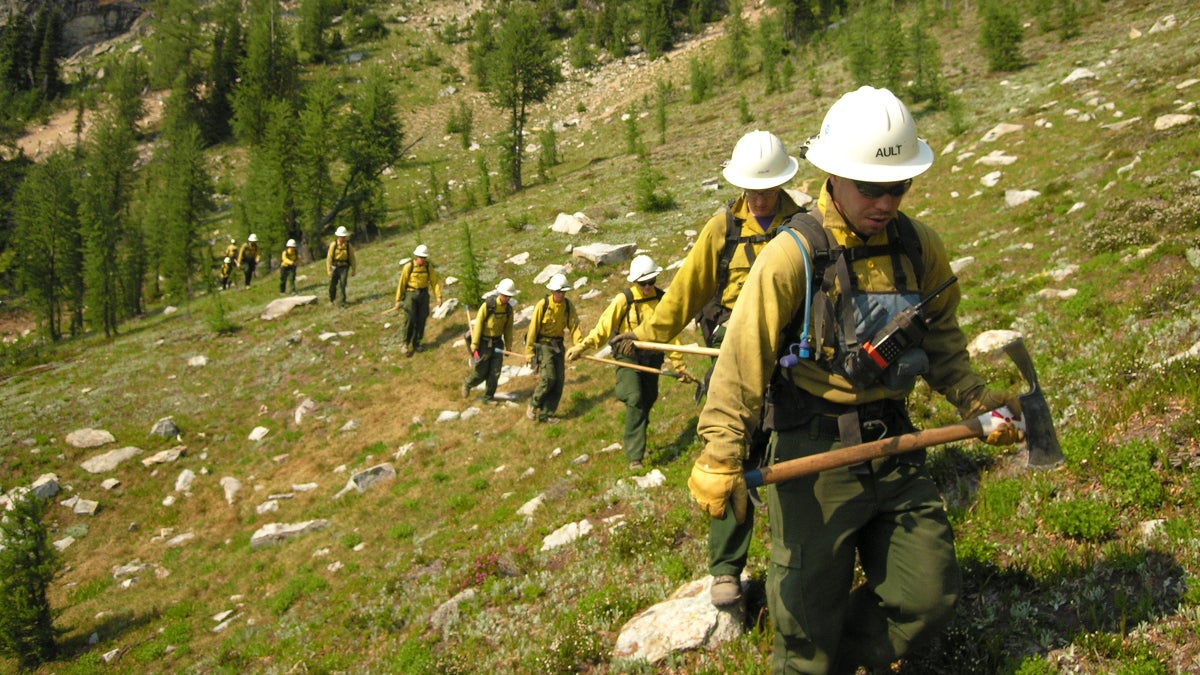
Many wildland firefighters work 72-hour shifts, which include hiking over rugged terrain with a pack that can weigh up to 90 pounds, explains former wildland firefighter Katy Luetke, a certified strength and conditioning coach for the California Department of Forestry and Fire Protection. And these firefighters need to be in shape nearly all year: Luetke says that while fire season in California used to last from June to October, it now runs from April through the end of December, thanks to drought conditions exacerbated by climate change. “Your ability to endure a season is very much dependent on both your endurance and your strength,” she explains. “The combination of those two factors is work capacity.”
The Workout
Luetke keeps her team fit for duty with moves like the ones below. She suggests starting with a ten-minute warm-up (she likes Turkish get-ups), followed by stretching. Cycle through the entire sequence three times, resting only as needed. You’ll need a moderate weight, a heavy weight, a pull-up bar, a rope, and a sandbag—feel free to improvise, though, using whatever household items you have. Luetke recommends completing the workout two to four times a week.
The Moves
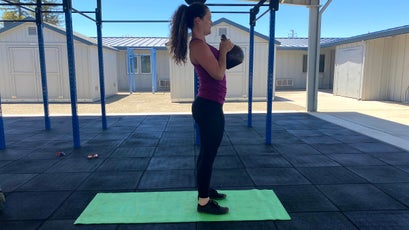
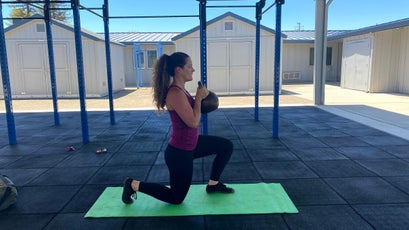
Reverse Goblet Lunges
What it does: Targets the lower body and core
How to do it: Using both hands, hold a medium-weight kettlebell (or dumbbell, cinder block, or whatever you have) to your chest. Stand with your feet hip-width apart, parallel to one another.
Engaging your core, take a big step back with your right foot, bending your right knee. At the same time, bend your left knee to about 90 degrees, making sure it doesn’t go past your left toes. At the bottom of the movement your right knee should graze the floor. Engage your left glute to stand, stepping your right foot forward to return to your starting stance. Alternate sides for a total of 16 reps.
Make it easier by using bodyweight, or increase the intensity by adding more weight.
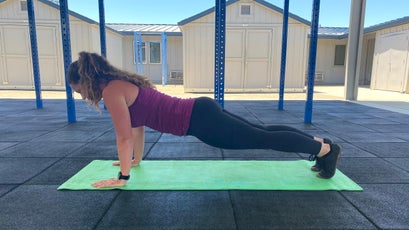

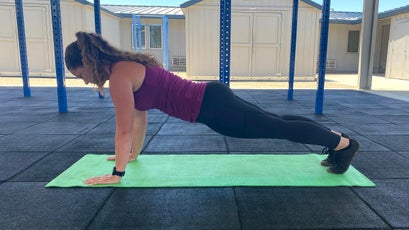
Push-Ups
What it does: Develops the chest, shoulders, triceps, core, and shoulder stabilizers
How to do it: Start by getting on all fours on the floor. Keep your wrists directly under your shoulders to make the move more challenging, or take a wider stance to make it easier. Extend your legs so that your knees are straight and your weight is distributed through your palms and your toes.
Retract your shoulders, engage your core, and bend your elbows to bring your chest down to the point where it grazes the floor. Straighten your elbows to return to the starting position. Maintain a neutral neck position throughout. Perform ten to 25 reps.
Need to dial down the intensity? Rest your weight on your knees instead of your toes. To make it harder, set a weight plate on your back or wear a weighted vest or backpack with something substantial inside. To avoid injury, progress gradually. Start with five pounds; once you can complete the higher end of the rep range with good form, increase the weight by another five or so pounds.
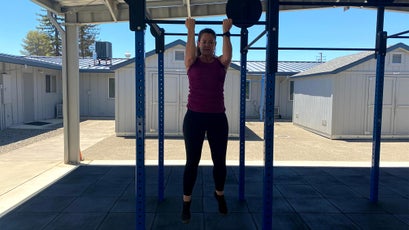
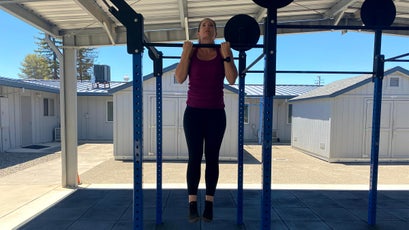
Pull-Ups
What it does: Strengthens the back, arms, and shoulders
How to do it: Start under the pull-up bar with your arms fully extended overhead. Grip the bar with your hands about shoulder-width apart using an overhand grip (palms facing away from you). If you’re still mastering the move, Luetke suggests starting with a mixed grip; use an overhand grip in one hand and an underhand grip (palms facing you) in the other. If you need to modify it further, use an underhand grip and do chin-ups instead—a chin-up involves the same exact movements as a pull-up; the only difference is your grip, which makes it easier.
For both chin-ups and pull-ups, retract your shoulders, engage your core, and bend your elbows to about 90 degrees, bringing your chin above the bar. To come down, extend your elbows slowly and with control back to the starting position. Complete as many reps as possible with good form.
To make it easier, use a super band (a thick looped band with a rectangular profile) for assistance, start with a jump, or do reverse rows (aka bodyweight rows) if you have access to a squat rack and a barbell or a TRX suspension trainer.
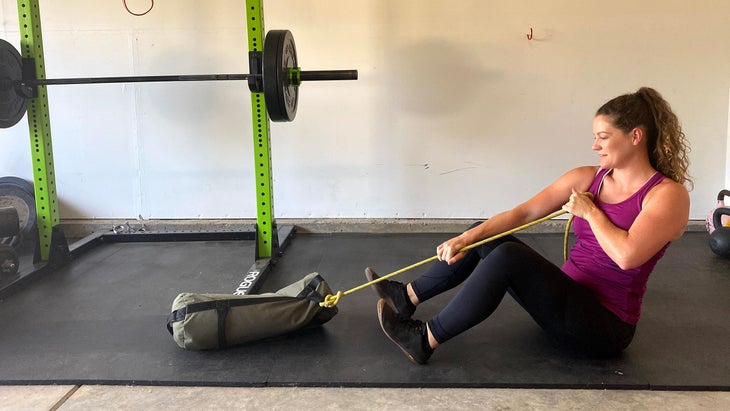
Sandbag Rope Pull
What it does: Works the back, shoulders, traps, and biceps
How to do it: Tie one end of a rope to a sandbag—this could be a duffel bag filled with sand, heavy books, rocks, bricks, or whatever you have. With the other end in your hands, unfurl the rope to its full length and sit on the floor with the bag in front of you. Bend your knees and plant your feet on the floor slightly wider than hip-width apart. Engage your core and lean back slightly.
With your palms facing one another, grasp the rope in each hand. With your right arm fully extended, reach down between your knees. Meanwhile, bend your left elbow so your left hand is holding the rope by your right armpit. As you bend your right arm to pull the sandbag toward you, release your left hand, straighten your left arm, grasp the rope between your legs, and pull. Continue until the sandbag is at your feet. Perform two rope pulls.
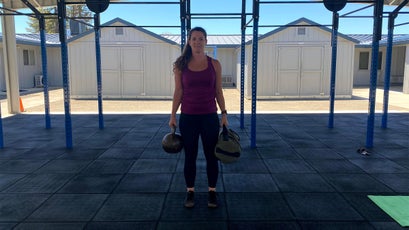
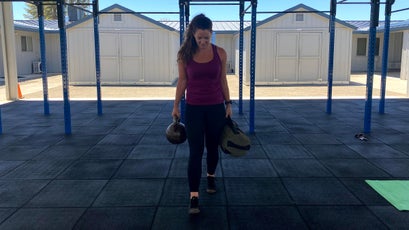
Uneven Loaded Farmer Carry
What it does: Targets the core, lower body, back, biceps, triceps, forearms, and hand muscles
How to do it: To start, deadlift a moderate to heavy weight into each hand from the floor, so that you’re holding them at your sides with your elbows fully extended. A dumbbell, kettlebell, or even a loaded duffel bag or suitcase will work.
To do a deadlift, stand with your feet about hip-width apart. Keeping your back flat and your chest up, slightly bend your knees and hinge forward from your hips while reaching down to grasp your weights, keeping your elbows extended. Thrust your hips forward to come back to a standing position with arms by your sides, keeping your core engaged throughout.
Luetke suggests using weights that are within 30 percent to 50 percent of each other’s weight, such as a 25-pounder and a 40-pounder.
At the top of the deadlift, hold your arms fully extended by your sides and walk at a comfortable pace with a weight in each hand for 30 seconds. Then set your weights down on the floor, switch hands, and deadlift them back up from the floor and walk for 30 more seconds, for a total of one minute. (Don’t worry about how far you can walk during that minute.)
The post Work Out Like a Firefighter appeared first on Outside Online.

